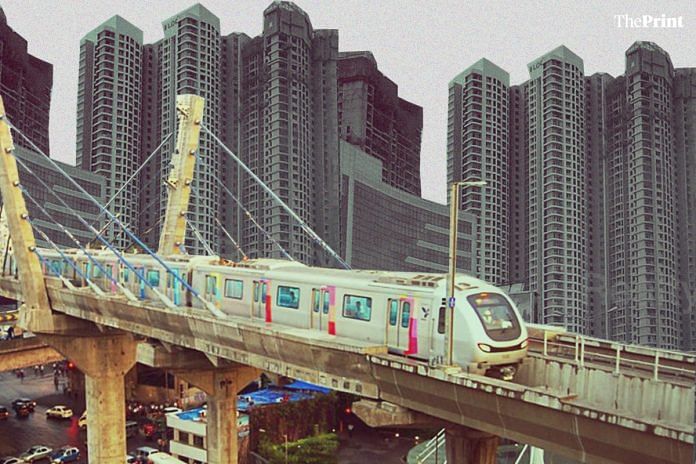Maharashtra government proposed a 1 per cent surcharge on stamp duty on the sale, lease, gift and mortgage of real estate in Mumbai, which takes the overall stamp duty to 6 per cent.
In a city where property prices are already sky high, the proposal has been widely criticised. The government’s rationale behind the hike is that it needs a constant stream of funds for several big-ticket urban transport projects that are underway.
ThePrint asks – Mumbai stamp duty hike: Milking unaffordable real estate or unavoidable source of funds for infrastructure?
If govt reduced stamp duty and rationalised GST, it would have collected more taxes
 Pankaj Kapoor
Pankaj Kapoor
Founder and Managing Director, Liases Foras
The real estate market has just started recovering because of the subventions and rebates provided by the government, and a rise in stamp duty will be counter-productive. The Mumbai real estate market has been in the doldrums, but there was a silver lining as real estate prices stopped rising in the last few months. The affordability gap reduced and more traction was seen. Over the last one year, sales in the Mumbai real estate market increased by 25 per cent largely because prices did not go up.
Ideally, for the market to recover, sales should increase manifold, but they are increasing marginally because prices have remained static. Builders don’t have margins to reduce prices. GST has been a burden, and a surcharge on stamp duty will further add to consumers’ woes because more taxation will mean that the builder will try to pass it on to the consumer. The move dilutes the Centre’s objective of providing affordable housing for all.
Real estate affordability is a major problem in Mumbai. The government should look at rationalising prices rather than increasing taxes. The inventory of unsold housing stock is still very high – at about 46 months in the Mumbai Metropolitan Region, and 50-55 months in the city. An efficient inventory ideally ranges between eight and 15 months. Sales have to improve dramatically for the inventory of unsold housing stock to be sustainable at a time when supply continues to grow.
Every time the government wants to raise funds, it milks the already unaffordable real estate market. Logically, it does not even serve its purpose. If the government had reduced stamp duty and rationalised GST, it would have collected more taxes. This increase in stamp duty will only dent tax collection.
It is incorrect to penalise one sector for another’s losses
 Ashok Datar
Ashok Datar
Chairman, Mumbai Environment Social Network
There are two elements to the proposed stamp duty hike to finance other projects. One, all metro projects are highly loss-producing, and there has been no thought on how to reduce these losses. For example, there is no need for four or five different metro lines. Two or three arterial ones would have sufficed and could be supplemented with bus corridors, cycling tracks and pedestrian walkways.
In Mumbai, the government is building a metro line on top of the Western Express Highway. Columns supporting the metro lines will take up two lanes on the road below, reducing space for vehicular traffic. On the same route, instead of a Rs 3,000-crore metro line, we could have managed with a Rs 100-crore bus lane and reduced costs.
Second, shouldn’t the government attempt to reduce the losses with interventions within the transport sector? The culprits are the car owners who are using much more than what they are paying for. The costs should be recovered through user fees from car owners. The government needs to charge higher parking fees. These can definitely be better tools to finance urban transport projects because there is a merit fee. It will discourage the use of cars by putting a price on it.
It is incorrect to penalise one sector for another sector’s issues, losses and gains. If at all the government still wants to have a stamp duty surcharge to finance infrastructure projects, it should only plan one for premium real estate – houses that cost more than Rs 20,000 per square feet.
Would’ve been better if surcharge was distributed holistically than just taxing home buyers
 Mayur Shah
Mayur Shah
Managing director, Marathon Group and president of MCHI-CREDAI
Mumbai’s real estate sector is already overtaxed with GST, registration and stamp duty, which anyway is quite high at five per cent. All the taxes together put a huge charge of 15-19 per cent on the home buyer. Land in Mumbai is costly. With the construction cost and taxes, the average price of a house is about Rs 1.5 crore. An additional one per cent surcharge over this will prove to be quite heavy for the buyer.
The move has been implemented in the Mumbai Metropolitan Region, and it has not gone down well with the buyers there. However, the impact of a one per cent surcharge is much lower on Mumbai’s satellite towns on the outskirts. In Mumbai, where average property prices are Rs 15,000-20,000 per square feet, a one per cent surcharge means an additional Rs 150-200 per square feet, which is daunting for the buyer. The government notification is not clear on how the surcharge is going to be levied across the city.
The intention behind levying such a surcharge, which is to raise funds for infrastructure projects, is good, but it would have been better if it was distributed more holistically rather than just taxing new home buyers.
The real estate market is definitely improving. We are seeing good traction across all our projects. Interest rates are low. Things are stabilising, and we don’t want any further disturbances that will again put the buyer in a thinking mode.
Some gains from real estate need to be invested in infrastructure projects
 Ashwini Bhide
Ashwini Bhide
Managing director, Mumbai Metro Rail Corporation
There is a correlation between infrastructure projects and real estate development. We have seen that infrastructure projects trigger real estate development. The real estate sector benefits because of the improved connectivity that transport infrastructure projects bring to the area. However, the gain has been one-sided till now. For example, when the government announced the first metro line and finalised its alignments, it gave a definite boost to the real estate around the area.
The idea now is to plough some of these gains enjoyed by the real estate sector back to infrastructure development. It will benefit the city and its people in the long run.
This kind of an impact fee is not a new idea. A number of countries have toyed with it. The issues of modalities and how such a measure should be implemented can be different.
The concept of capturing land value gain has always been there, but when we actually try to translate it on ground through certain tools, it gets complicated. A development fee through a stamp duty surcharge is a relatively easy tool for capturing land value gain, and is easier to put in a legal format too.
Surcharge on property transactions in US, UK, China remain controversial
 Manasi Phadke
Manasi Phadke
Associate Editor, ThePrint
Two severe issues that Mumbai citizens grapple with are transport and housing. These two sectors need serious interventions to improve life in the city. Proposing a stamp duty surcharge on property transactions to fund infrastructure projects is a short-sighted approach that seeks to tackle one problem while worsening the other.
Buying a house in Mumbai is a distant dream for most. If at all, one reaches close to that dream by pooling in all the resources at one’s disposal, the process completely wipes out any savings. In this situation, even coughing up an extra Rs 1.5-2 lakh for a decent home is a daunting task. This is an additional burden on home buyers who anyway feel short-changed paying lakhs for a matchbox house in an area far from their workplace.
At the same time, Mumbai is undergoing a massive transport infrastructure overhaul with four metro lines and a costly sea link underway. There are more projects in the pipeline that promise to ease the burden on the transport sector. So far, the Mumbai Metropolitan Region Development Authority (MMRDA), the nodal agency in charge of most of Mumbai’s infrastructure building, has relied on its extensive land bank and loans from international funding agencies. However, beyond these, there needs to be a sustainable source of funds to be able to satisfy Mumbai’s current and future needs.
A development fee, which is essentially a surcharge on property transactions, is routinely applied in many countries such as the UK, the US, Canada and even China, although the concept remains controversial even in these countries. For such a surcharge to be levied in Mumbai, the government first needs drastic interventions to control prices when the inventory of unsold housing stock is already high.
Meanwhile, for a sustainable source of funds to create infrastructure, the government can look within the transport sector itself – perhaps a surcharge on car purchases, parking fee or a congestion fee.
Compiled by Manasi Phadke, associate editor at ThePrint.







Metro will definitely, ease down the traffic problem being faced by mumbaites, and the infrastructure development undergoing and propoposed, will definitely uplift the property price in Mumbai and would be a good tool for the Real Estate Industry’s enhancement, which has been undergoing in a bad period since last 2+ years.
As far as levying 1% extra stamp duty, though it’s not a bad idea to get a recurring income to MMRDA, is limited to only transaction base, means 1% extra stamp duty would be applicable to new buyer or sale/purchase of existing property, whereas the benefits of Metro and other Infrastructure would be available to all the people. So, instead of collecting 1% as extra stamp duty, it would have been a wise decision to increase the property tax being paid by property owner every year and also collecting extra tax on vehicle moment within Mumbai, including from those outside vehicles coming into Mumbai.
Rajeevan Nair
Exdcutive Vice President & Chief Legal Officer
Mumbai Resident
The problem is not with the taXes,but the builders who are racketeers and indulge in profiteering rather than profit making. For the unfortunate home buyers, whose life savings these rascals have squandered in their greed, they are financial terrorist. Two successive non corrupt and no nonsense Chief Minister’s, Prithviraj Chavan and Fadnavis have brought this organised builder mafia to its knees. The builders policy of Everyone can be bought and any law can be circumvented is not working now.
MMRDA has been unable to sell its residual commercial plots in the Bandra Kurla Complex because its price expectations are unrealistic, unsupported by the state of the real estate market. It is undertaking large infrastructure projects, especially in mass transport, without having established their economic viability. ILFS, the big daddy of infrastructure, is on the verge of being unwound, with a huge inventory of dud projects. Greater care and thoughtfulness are required, instead of merely squeezing an already downbeat property market.